E-Travel Log # 5: African Animal Safari!
Dear students:
Welcome to Etosha
National Park! This week, Lilia and I took a break from visiting schools to
go on safari. We’ve spent the past two days in one of the world’s most famous
parks. It’s famous, of course, for its animals. So, in this report we’ll
tell you about our visit to Etosha; give you our Etosha animal list; challenge
you with an animal/flower naming activity and another guess-who animal poem;
and end with more questions and answers. As usual, we’re also including
a batch of photos – only this time, each one has a certain twist. See
if you can figure out the animal or the part of the animal or what’s
really going on. Enjoy – but don’t get out of your vehicle! (It’s
a game park rule.)
We’ve spent the past two days in one of the world’s most famous
parks. It’s famous, of course, for its animals. So, in this report we’ll
tell you about our visit to Etosha; give you our Etosha animal list; challenge
you with an animal/flower naming activity and another guess-who animal poem;
and end with more questions and answers. As usual, we’re also including
a batch of photos – only this time, each one has a certain twist. See
if you can figure out the animal or the part of the animal or what’s
really going on. Enjoy – but don’t get out of your vehicle! (It’s
a game park rule.)
BIRD, SNAKE OR FLOWER?
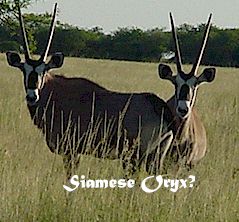 In
an earlier report, we included an activity about antelopes with interesting
names. In Etosha, we also saw lots of birds with interesting names, like the
spectacularly colored lilacbreasted roller. (It has no less than six beautiful
colors on it.) But, besides being interesting, its name is very descriptive.
The first part describes the color of its breast and the second part describes
how it flies: When it chases after large flying insects, it sort of rolls
to one side then the other.
In
an earlier report, we included an activity about antelopes with interesting
names. In Etosha, we also saw lots of birds with interesting names, like the
spectacularly colored lilacbreasted roller. (It has no less than six beautiful
colors on it.) But, besides being interesting, its name is very descriptive.
The first part describes the color of its breast and the second part describes
how it flies: When it chases after large flying insects, it sort of rolls
to one side then the other.
Well, with a bit of research, we’ve found that there are also many reptiles and flowers in southern Africa with descriptive and interesting names. Here's a language arts sleuthing activity about bird, reptile and flower names. Better put your detective’s cap on! Each set of names below contains one bird name, one reptile name and one flower name. All you have to do is determine which is the bird, which is the reptile and which is the flower. Easy, right? Well, don’t be discouraged by the fact that you may never have heard of most of the mystery species on the list: many of the names contain clues that will help you to solve the case – and, by Jove, I think you’ll even have fun! We’ll list the answers in the next report.
1. spiny agama
Livingston's blue commelina
pied avocet
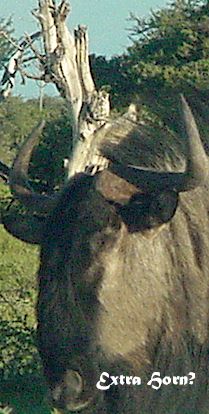
2. three-banded courser
two-striped shovel-snout
natal red top
3. scimitar billed
woodhoopoe
doll's powder puff
snouted night adder
4. short-legged sep
pig's ear
redknobbed coot
5. violeteared waxbill
rhombic skaapsteker
pink-spike erica
6. giant legless skink
purple berkheya
purple gallinule
7. fierynecked nightjar
Bibron's burrowing asp
yellow mouse-whiskers
8. silver veronica
southern brown eggeater
orangethroated longclaw
9. firecrowned bishop
striped blind legless skink
small white albuca
10. devil's thorn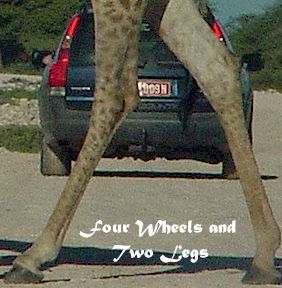
forktailed drongo
western dwarf burrowing skink
11. variegated slugeater
fishbone cassia
rattling cisticola
12. chestnutvented
titbabbler
giant pink everlasting
speckled padloper
13. blackcrowned tchagra
many-horned adder
wart-stemmed pincushion
14. yellow bushman's
candle
yellowbreasted hyliota
green mamba
15. hairy nidorella
ruddy turnstone
shieldnose elapid
16. black mamba
red paintbrush
spotted dikkop
17. arrowmarked babbler
red hot poker
Namibian wolf
18. waterfinder
monkey's tail
desert broom
(OK, that last one has a trick to it: All three species are members of the same category.)
ETOSHA: WILDLIFE MAGNET
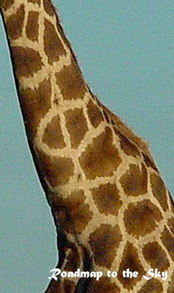 Etosha,
which is located in northern Namibia, is one of the largest game parks in
Africa. Besides being protected land, Etosha attracts animals because it is
home to one of the largest pans in the world. Not frying pans! Salt pans.
A pan is a shallow depression in the
Etosha,
which is located in northern Namibia, is one of the largest game parks in
Africa. Besides being protected land, Etosha attracts animals because it is
home to one of the largest pans in the world. Not frying pans! Salt pans.
A pan is a shallow depression in the
earth where rain water drains. So, when it rains a lot, the pan fills up;
and when it doesn't rain, the pan dries up. The Etosha Pan is so large that
astronauts can see it, shining white, from outer space. It has an area of
4,590 square kilometers. (Can you figure out how big the pan is in square
miles? How does the pan's size compare to the largest lake in your state?)
In the winter dry season, summer in the northern hemisphere, thousands and
thousands of animals make their way to the pan – for water and the vegetation
that the water supports. In the wet winter season (now), many of those animals
wander away from the pan in the vast stretches of land that surround it, since
water and green stuff can be found in other locations. So, this time of year,
the animals are fewer and farther between in Etosha than in the winter –
and some animals are very hard to see. This time, we saw thousands of animals
– but most were zebras, wildebeest, springbok, giraffes, ostriches,
oryx and black storks.
On Safari!
Last year when we visited Etosha, we saw a wider variety of animals. Here’s the list of animals we’ve seen here this year and last:
-
Thousands of herding springbok (including many bouncing babies – especially the young ones like to bound around like kangaroos -- and they are so fun to watch)
-
Hundreds of shaggy blue wildebeest (some with calves)
-
Hundreds of flamboyant flamingoes (lesser and greater)
-
Hundreds of black storks
-
Hundreds of plump Burchell’s zebra (also with lots of youngsters)
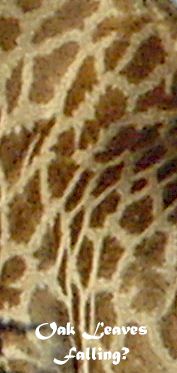
-
Over a hundred sleek black-faced impala
-
Over a hundred slow-witted helmeted guineafowl (who always run out in front of your car and act like they don’t know how to get out of your way)
-
Over a hundred stately oryx (a.k.a. gemsbok – and the official animal symbol of Namibia – appearing on the country’s shield)
-
Dozens of animal-following cattle egrets (who eat insects stirred up by animals walking through the grass)
-
Dozens of graceful giraffe
-
Tens of magnificent lilacbreasted rollers
-
Tens of Hartmann’s mountain zebra
-
A couple dozen curious jackals
-
A couple dozen bulky kori bustards (Africa’s largest flying bird)
-
A couple dozen striking European bee-eaters
-
Several families of busy banded mongooses (including many babies)
-
Several families of disproportionate ostriches
-
Two impressive elephant families (with several youngsters)
-
A dozen or so noisy grey lauries
-
A half a dozen loping hyenas (five were taking a bath in a waterhole and all the other animals waited warily for them to leave before they got their drinks)
-
Several ground squirrels
-
A few diminutive steenbok
-
A few chicken-like red-billed francolins
-
One massive black rhinoceros
-
One cute little leopard turtle
-
One tawny eagle
-
And one quaking chameleon (who walked slower than the turtle and acted like he was quivering in the wind like a leaf).
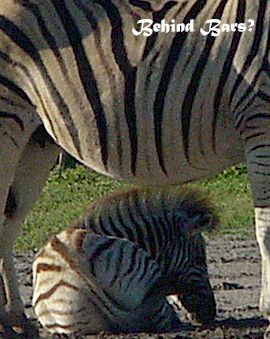 We
saw lots of other birds, too, some of which we were able to identify and others
we were not. Some of the ones we identified are as follows: black khoraans,
blacksmith plovers, African crakes, redbilled queleas, grey hornbills, red-billed
hornbills, yellowbilled hornbills, blue cranes, herons, shrikes and hawks.
We
saw lots of other birds, too, some of which we were able to identify and others
we were not. Some of the ones we identified are as follows: black khoraans,
blacksmith plovers, African crakes, redbilled queleas, grey hornbills, red-billed
hornbills, yellowbilled hornbills, blue cranes, herons, shrikes and hawks.
We’ll be including lots more animal photos from Etosha in our next two reports.
GUESS WHO
Here's a guess who animal poem. It tells a traditional African story. Can you guess which animal is telling the story? Here's a hint: We saw this animal at Etosha. The title is the Swahili word for the animal speaker.
Kifaru
In an old story
The Creator felt sorry
For he made all the beasts without horns and coats
The zebras looked like donkeys
The gorillas looked like monkeys
And the Thompson's gazelles looked like goats
He said, "Oh, what a wonder
What a thundering blunder
I just knew that I left something out
If I don't change the features
Of these resembling creatures
When I try to distinguish I'll always have doubt"
So back to the drawing board
To retap his thinking gourd
The Big Guy went with a hammer and thread
Horns and sweaters
Of ivory and leather
He crafted till well past the hour for bed
The next morning at dawn
He bid the animals come
To a cave where he displayed all the styles brand new
The animals rushed
And some of them pushed
For such a sale only comes when the moon turns blue
The Creator said with pride
Take two horns and a hide
Whichever ones you think will fit you best
So the animals lunged
And the greedy ones plunged
And came out with a tie and a vest
But unfortunately for me
Since quite poorly I see
I grabbed uneven horns and a suit three sizes too large
I'll admit I was sad
But made the best of what I had
And put the horns on my nose should I ever need to charge
And those horns still haunt me
For the poachers now want me
And they kill me if they can get past the ranger
So I'm on the brink
Of becoming extinct
And because I never wore glasses I'm now considered
endangered
---------------------------------------------------------
By the way, the answers to the last report's poems are the cheetah (again) and the leopard.
QUESTIONS AND ANSWERS
The following questions, posed by third grade students at the Oakdale Elementary School in Ijamsville, MD, were answered by third grade students at Van Rhyn Primary School, Windhoek.
1.
What kind of clothing do you wear (including shoes)? We wear dresses, skirts,
T-shirts, jackets, jeans, shorts, vests and school uniforms. Sometimes we
wear our African dresses at home, which are like colorful long-sleeve dresses.
Some students are from different tribes and they wear their traditional outfits
too. For shoes we wear sandals, dress shoes, slippers and running shoes (Nike
and Adidas).
2. What sports and games do you play? We play basketball, netball, soccer,
tennis, hockey and cricket. We all love swimming and running, too. Some of
us do gymnastics at school and some others dance ballet. We play games such
as mama goose and touch, and we like to play in the playground.
3. What is the biggest river in Africa? It’s the Nile. It’s
the longest river in the world, too.
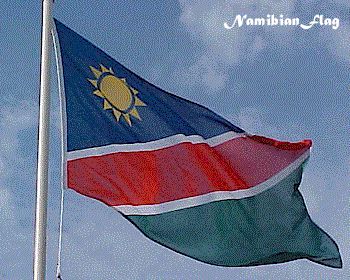 4.
What does your flag look like? This is what our flag looks like (see picture).
The color red represents the blood of the people that sacrificed their
lives for the independence of Namibia; the green is the color of plants and
it represents life; blue represents the sky; the color white represents peace
and unity and the yellow sun tells you that Namibia is a desert country.
4.
What does your flag look like? This is what our flag looks like (see picture).
The color red represents the blood of the people that sacrificed their
lives for the independence of Namibia; the green is the color of plants and
it represents life; blue represents the sky; the color white represents peace
and unity and the yellow sun tells you that Namibia is a desert country.
5. What means of transportation do you use? We use cars, trains, airplanes,
buses, taxis, trucks, bicycles, motorbikes and boats.
6. Do you have police and what do they wear? Yes we do. They wear very
nice uniforms of different colors – maroon, brown, dark brown, white
and grey.
7. What do you do in your free time? We play soccer and basketball. We
read books, watch TV and movies. We go bowling. We sing, dance and ride our
bikes.
8. What musical instruments do you play? We play guitar, piano, keyboard
and drum. We also sing and dance to our traditional music a lot.
The following questions, also posed by third grade students at the Oakdale Elementary School in Ijamsville, MD, were answered by 3rd-6th grade students at Hanganeni Primary School, Swakopmund.
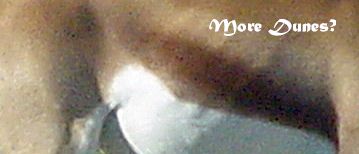 1.
What is your house made of? Our houses are made of bricks, sand, rocks,
cement and sometimes wood sticks.
1.
What is your house made of? Our houses are made of bricks, sand, rocks,
cement and sometimes wood sticks.
2. What is the name of your school? It’s called Hanganeni, which
means ‘ Lets come together’ in the Owambo language.
3. How hot and cold does it get? Swakopmund is close to the beach so the
weather is cool and mild. The temperature goes from 15 to 25 degrees (Celsius)
during one day. In the summer time (December), the temperature rises a bit
and people go swimming at the beach in the Atlantic Ocean even though the
water is very cold.
4. What kind of stores do you have? We have many different kinds of stores
and supermarkets, such as Shoprite, Pick & Pay, Comprite, Woerman and
Broek, Style, Comando, Ackermans, Gala, Pep and Mr. Price.
5. Do you speak different languages? Yes. Although English is the official
language, we all speak our 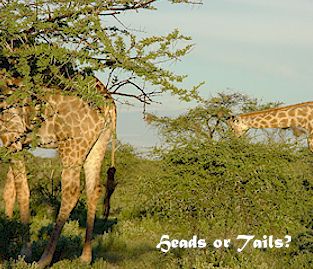 own
tribe languages such as Damara, Ovambo, Herero, Setswana, Portuguese, German,
San/Bushman language and Caprivian. But we also all speak Afrikaans, because
it used to be the official language.
own
tribe languages such as Damara, Ovambo, Herero, Setswana, Portuguese, German,
San/Bushman language and Caprivian. But we also all speak Afrikaans, because
it used to be the official language.
6. What types of animals and plants/trees are in your region? We have cats,
dogs, chickens, horses, snakes, springboks, wild cats, wild dogs, ostriches,
rabbits, sea horses, whales, flamingoes, dolphins, tortoises, star fish, sharks,
octopus and penguins. We have sea weed, palm trees, small thorn bushes, pine
trees and flowers.
7. What is your favorite subject in school? Math is the #1 favorite, but
some of us like other subjects like Art, P.E., Science, English and Library.
8. What do you like to eat and drink for something sweet? We like cake,
cool drinks (sodas), bananas, ice cream, chocolate and strawberries.
9. Do you hunt? No.
10. If you had one wish, what would you wish for? (Individual students gave
the following replies:) a bike, a  house,
a carrot, a traditional drink with milk and corn meal, to pass my grade, an
apple, a car, to be able to fly, to be able to fight like Jackie Chan.
house,
a carrot, a traditional drink with milk and corn meal, to pass my grade, an
apple, a car, to be able to fly, to be able to fight like Jackie Chan.
11. What type of jewelry do you wear? Where do you get it? We like earrings
and necklaces, of both silver and gold. We can get them anywhere - at the
market, the malls and jewelry shops.
12. Do you have camps that you go to? What kind? We sometimes go camping
with our parents to the camp sites close to the sand dunes or on the beach
to see the seals. Our school sometimes organizes camping trips to Cape Town.
We also have soccer camps and prefect camps.
THAT’S ALL FOR NOW
That’s it for this report. Next week, we’ll be traveling to two schools in the Kalahari Desert region of Namibia. We won’t have access to the Internet while we’re gone, so we’ve prepared two other reports which you’ll get during the week. In those reports, we’ll include lots more animal photos we took at Etosha, plus some photos we took while traveling. We’ll tell you about the Kalahari and the students there when we get back. Till then, learn lots!
Paul and Lilia
Africa School Project Coordinators
<><><><><><><><><><><><><><><><><><><><><><><>><><><><><><><><><><><><><>
Teachers:
Here's another idea for using the language arts activity at the top: Choose a name from the list and do research to discover how the bird, reptile or flower matches its name. Find out as much as you can about the species. Then, invent your own species and name it with a descriptive and interesting name. Describe it, listing its characteristics and behavior, including what eats it and/or what it eats. Then draw your new species so others can see it. Have fun!

